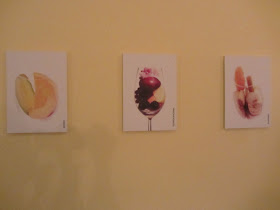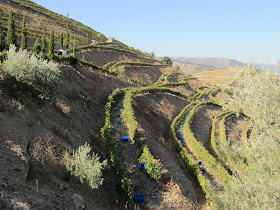The Yeatman is owned by Fladgate Partners which, in addition to the hotel, controls such fabled Port labels as Taylor's, Croft, and Fonseca and a number of Quintas (estates) on the Douro, upriver of Porto. The hotel, which came online in the summer 2010, is designed with the ground floor as its highest point with guest rooms sunk into the face of the hill below. Travel from the reception to a guest room requires taking an elevator downwards. According to the hotel sommelier, Croft, Delaforce, and Fladgate Port Lodges were destroyed to make room for the hotel.
 |
| The Yeatman as seen from the river bank |
The common areas of the hotel are tastefully designed and decorated with the internal designs flowing gracefully outwards from large, glass-enclosed spaces to terraces and patios which direct the eyes outwards towards the Douro and Porto rather than to the Port Lodges directly below.
There is not a single guest room with a bad view as all 82 rooms have a similar northward-facing view and a private balcony from which to soak in the sun and the view. Amenities abound. The hotel boasts a restaurant, breakfast room, and pool bar, all well-appointed and, of course, overlooking the Douro and Porto.
The wine focus of the hotel becomes apparent as soon as you step into the elevator. The leftmost elevator (as you face them) is decorated (fully) with an amazing panoramic view of a Douro vineyard. In juxtaposition, the second elevator is decorated such as to give the impression that you are in a Port Lodge. I have never thought of the inside of an elevator as being picture-worthy but both of these are.
The elevator lobbies on the guest-room floors, the halls leading to the lobbies, and the guest-room hallways are all decorated with maps of the Douro (river and region), pictures of vineyards, and scenes from the production and storage of Port. On the walls leading to the wine cellar, there are plaques and framed matter showing the primary Portuguese wine regions and representing Portuguese varietal aromas as fruits in a glass.
Wine can be bought at the hotel in the restaurant, at the pool bar or at an attractively stocked lobby shop. The hotel describes the restaurant wine list as being the best Portuguese wine list in the world.
In order to gain better insight into the hotel's wine activities, I arranged for a tour of the wine cellar with Elisabette, the restaurant sommelier. We met in the main lobby and then worked our way down to the cellar (We were joined in this adventure by two other couples from the Decanter Reader Team.).
As we entered the cellar, we were confronted by a large, free-standing wall that stood to the right of the entrance and was adorned with name plates. Elisabette explained that these were the names of the hotel's Wine Partners, the producers of the best wines in Portugal. Each partner, according to Elisabette, gave their name to a room and was allowed to decorate it in a manner which promoted their wines. The partner wines are on the restaurant wine list which is organized into Chapter 1 (by the glass), Chapter 2 (bottle), and Chapter 3 (vintage; requires a trip to the wine or port cellar). In addition to the general wine list, there is a weekly list which features the wines of an estate by the glass. That particular wine is promoted heavily by all of the hotel's outlets during that week. Also during that week, a dinner featuring that wine, and complementary fare prepared by the chef, will be held.
The Yeatman cellar is home to 25,000 bottles drawn from 800 primarily Portuguese labels. The wines are arranged in the cellar from the northernmost Portuguese wine region southwards and the management of the contents are the responsibility of a full-time cellar master.
The management of the Yeatman has successfully melded the themes of luxury and wine into a seamless whole which is pleasing to the senses. The partner advertising in the rooms are very understated and appear more as accents than sales pitches. The wine list is impressive in terms of the volume of Portuguese wines included and Elisabette is of inestimable value in helping you navigate through it. I liked this hotel.















































